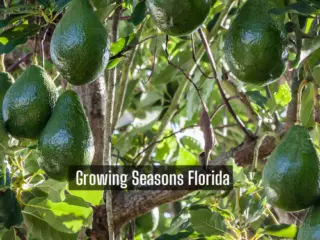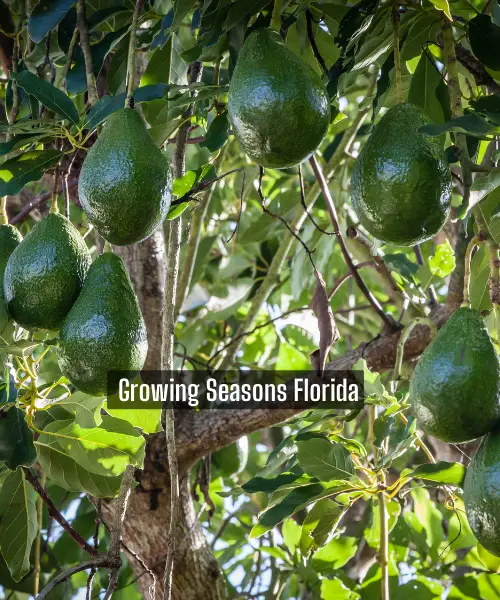For gardeners in Florida, understanding the state’s unique growing seasons is key to a successful and bountiful harvest. With its subtropical to tropical climate, Florida offers an extended period for cultivating a wide variety of fruits, vegetables, and ornamental plants.
However, the growing seasons can vary depending on your specific location within the state. To help navigate this diversity, the University of Florida’s Institute of Food and Agricultural Sciences (UF/IFAS) has developed a handy resource: the Florida Growing Season Chart.
The Beauty of Multiple Growing Seasons
One of the greatest advantages of gardening in Florida is the ability to grow crops during multiple seasons throughout the year. Unlike many other regions where the growing season is limited to the warm months, Florida’s mild winters allow for year-round cultivation of certain plants. The Florida Growing Season Chart divides the state into four distinct zones, each with its own set of recommended planting and harvesting times.

Florida Growing Season Chart
Zone 1: The Cool-Weather Zone


The northernmost region of Florida, Zone 1, experiences cooler temperatures during the winter months, making it more suitable for cool-season crops like broccoli, cabbage, carrots, and leafy greens. The growing season in this zone typically runs from September through May, with peak production occurring during the spring and fall months.
Zone 2: The Central–Northern Zone
As you move southward into Zone 2, the growing season extends slightly longer, typically from August through June. This zone is well-suited for warm-season crops like tomatoes, peppers, and eggplants, as well as cool-season vegetables. Gardeners in this region can enjoy a continuous harvest by carefully timing their plantings and successions.
Zone 3: The Central-Southern Zone
Zone 3, which encompasses the central and southern portions of the state, boasts an extended growing season that runs from March through November. Here, warm-season crops thrive, and tropical fruits like mangoes, avocados, and papayas can be successfully cultivated. Additionally, this zone is ideal for growing herbs and ornamental plants that appreciate the warmth and humidity.
Zone 4: The Tropical Zone
The southernmost region of Florida, Zone 4, is truly a gardener’s paradise. With its tropical climate, the growing season in this zone is nearly year-round, allowing for the cultivation of a wide range of tropical fruits and vegetables. From bananas and pineapples to cassava and malanga, gardeners in this region can experiment with a diverse array of exotic crops.
Timing is Everything
While the Florida Growing Season Chart provides a general guideline for planting and harvesting times, it’s essential to consider your specific microclimate and soil conditions. Even within the same zone, variations in temperature, rainfall, and soil quality can impact the success of your garden.
One crucial factor to consider is the risk of frost. While much of Florida enjoys a relatively mild winter, northern regions and inland areas can still experience occasional frost events. Paying close attention to local weather forecasts and being prepared to protect sensitive plants during cold snaps can help ensure a successful harvest.
Crop Rotation and Succession Planting
To maximize your garden’s productivity and prevent soil depletion, it’s recommended to practice crop rotation and succession planting. The Florida Growing Season Chart can be a valuable tool in planning your crop rotations, as it outlines the ideal planting times for different vegetable families.
Succession planting, the practice of staggering plantings of the same crop throughout the growing season, can also help extend your harvest and ensure a continuous supply of fresh produce. By carefully timing your plantings based on the recommendations in the chart, you can enjoy a steady stream of vegetables and fruits throughout the year.
Adapting to Climate Change
As climate patterns continue to shift, it’s essential for gardeners to remain adaptable and adjust their planting schedules accordingly. The Florida Growing Season Chart is a living document, regularly updated by UF/IFAS to reflect the changing growing conditions across the state.
One notable impact of climate change in Florida is the potential for longer warm seasons and shorter cool seasons. This could mean an extended growing period for warm-season crops but a compressed window for cool-season vegetables. Gardeners may need to adjust their planting dates and consider using shade cloth or other protective measures to extend the cool-season window.
Embracing Sustainable Gardening Practices
In addition to following the Florida Growing Season Chart, it’s crucial for gardeners to embrace sustainable practices that promote the long-term health of their gardens and the environment. This includes techniques such as:
1. Composting: Incorporating nutrient-rich compost into your soil can improve soil structure, water retention, and overall fertility, reducing the need for synthetic fertilizers.
2. Mulching: Applying a layer of organic mulch helps retain moisture in the soil, suppresses weeds, and insulates the soil from temperature extremes.
3. Integrated Pest Management (IPM): IPM strategies focus on preventing and managing pests through cultural, biological, and mechanical methods, minimizing the need for harsh chemical pesticides.
4. Water Conservation: Implementing water-efficient irrigation systems, such as drip irrigation or soaker hoses, can reduce water waste and ensure that your plants receive the appropriate amount of moisture.
Celebrating Florida’s Bounty
The Florida Growing Season Chart is more than just a practical tool for gardeners; it’s a celebration of the state’s incredible agricultural diversity and abundance. By following the recommended planting and harvesting times, you can fully embrace the joy of growing a wide variety of delicious and nutritious fruits and vegetables throughout the year.
Whether you’re a seasoned gardener or just starting your journey, the Florida Growing Season Chart can be your guide to unlocking the full potential of your garden. Celebrate the state’s bountiful growing seasons and let the chart inspire you to experiment with new crops, try new gardening techniques, and savor the flavors of fresh, locally grown produce all year round.




